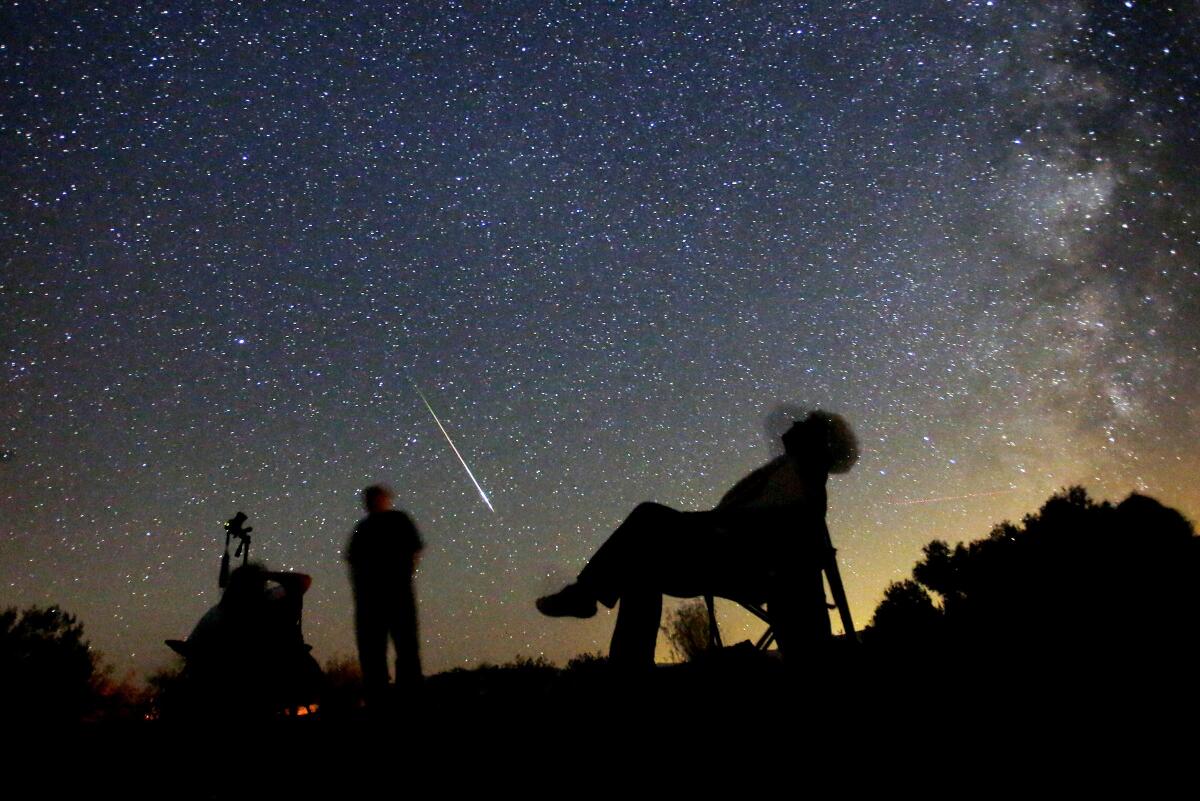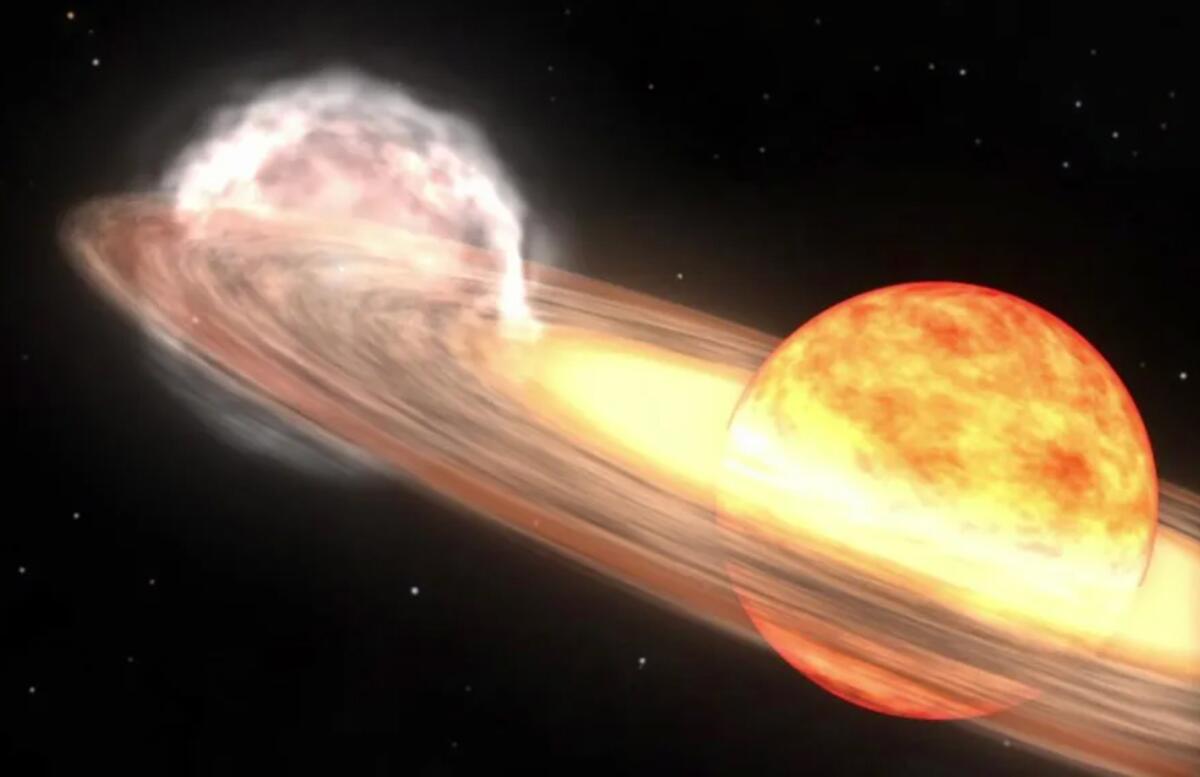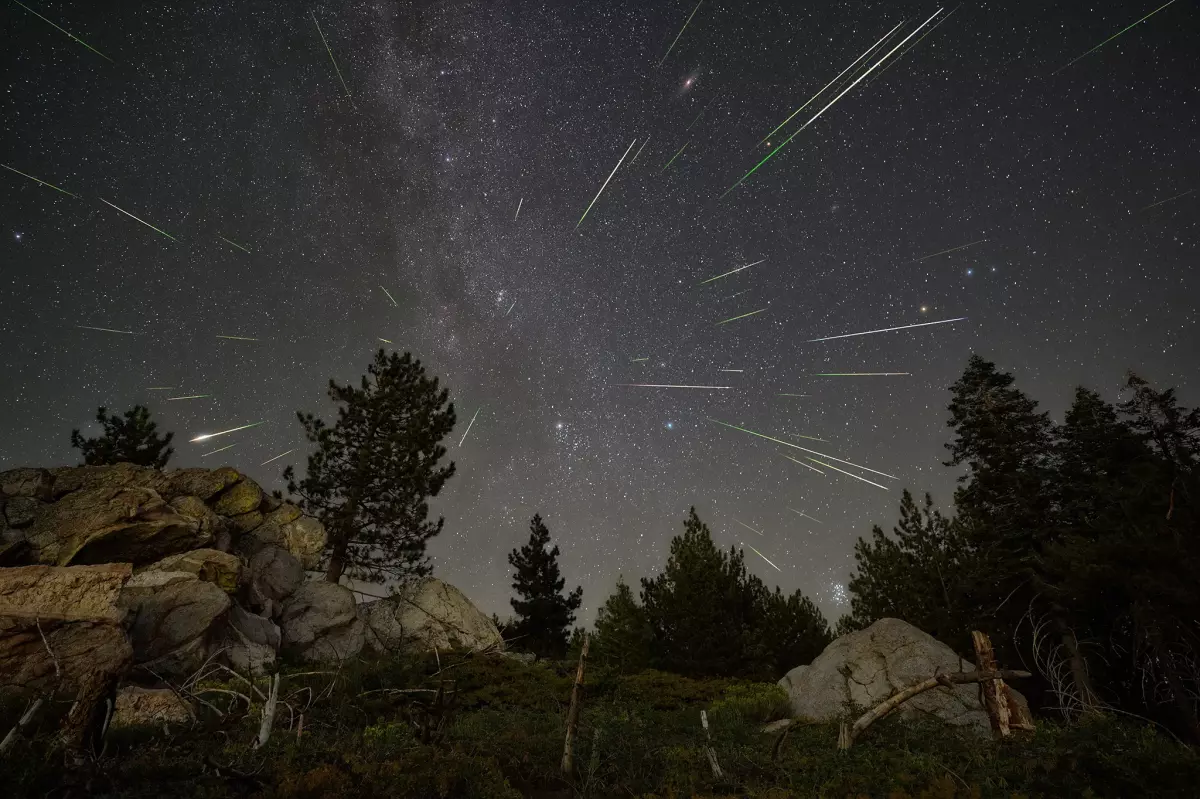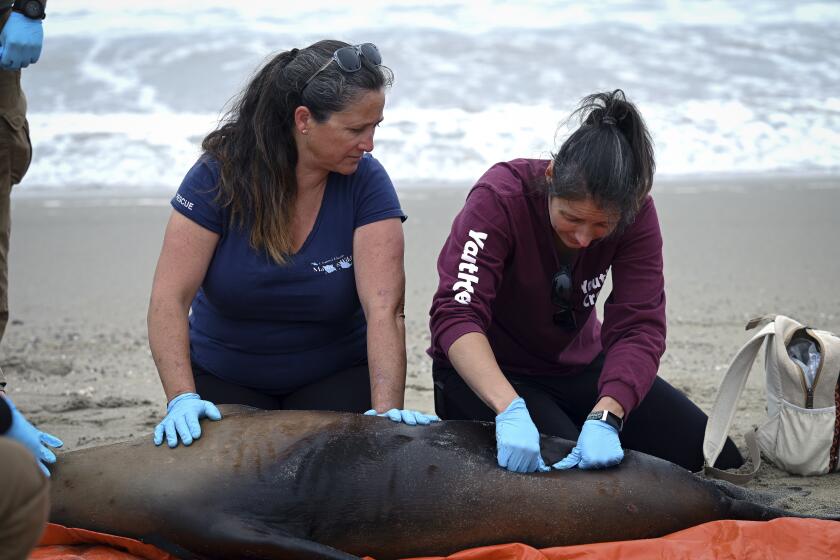Summer stargazing is in for a bright start with meteor showers and an exploding star

Good morning. It’s Friday, July 2. Here’s what you need to know to start your day.
- Starry nights take center stage with an exploding star and meteor showers.
- L.A. County agrees to buy a downtown skyscraper.
- The best L.A. culture this week.
- And here’s today’s e-newspaper
You're reading the Essential California newsletter
Our reporters guide you through our biggest news, features and recommendations every morning
You may occasionally receive promotional content from the Los Angeles Times.
An exploding star, satellite brush strokes and a seasonal light show
Let’s talk about space, because space is cool.
It’s been a good year for astronomy buffs. We witnessed a total solar eclipse (partial for California), a U.S.-based craft landed on the moon for the first time in 50 years, and a NASA rover found a rock that raises the question: Was there life on Mars?
And the cosmic calendar is stacked this summer, with a distant star’s explosion about to become visible on Earth, multiple meteor showers and more frequent rocket launches.
There’s plenty for Californians to see — if you know where and when to look (pro tip: start by looking up).
How to spot the nova
Technically speaking, the “Blaze star” blew up roughly 3,000 years ago. But the light from that star explosion, or nova, is slated to reach Earth soon, likely before August ends.
“It’ll be about as bright as the North Star, making it visible to the naked eye — even with Los Angeles’ light pollution,” Times reporting fellow Noah Haggerty wrote this week. “You have just two or three days in Los Angeles — or about a week out in the desert — to hope for clear weather and try to spot it.”
Noah recommends following NASA Universe on X, formerly Twitter, for word when the nova pops off. You might find out a little sooner if you sign up for instant email notices from the Astronomer’s Telegram.
The exploding star is part of the U-shaped constellation Corona Borealis, which from our earthly vantage point is near the Big Dipper’s handle.

If that’s not helpful enough, you can do what I had to do to figure out where to look: use the Stellarium app and search for the star under its shorthand name, T CrB. Make sure your location is accurate.
The nova may be visible in the city, but Tim Thompson, science director at Mt. Wilson Observatory, said it’ll be best viewed far away from the “light bucket” that is the L.A. Basin.
“If you don’t know sky, you’re not going to recognize that there’s a new star, especially in Los Angeles, because you can’t see any stars in Los Angeles anyway,” he told me.
Catch the seasonal light show
Did you know it’s space rock season? There are currently three meteor showers active in Earth’s atmosphere: the Southern Delta Aquariids, Alpha Capricornids and Perseids.
Bill Cooke, who leads NASA’s Meteoroid Environment Office, told me that the Perseids, which will peak Aug. 11 overnight into Aug. 12, are by far the best show in town.
“There are lots of large particles in the Perseid debris trail, and as a result, it is No. 1 among all meteor showers in terms of numbers of fireballs,” he said. “[They’re] not only fast, but they’re bright, and the Perseids are the ones that come closest to creating fireworks in the sky.”
Both Cooke and Thompson had the same key advice for viewing the Perseids’ light show: go where it’s dark, as in the deserts or mountains.

Joshua Tree National Park is a popular destination, Thompson said, and some astronomers gravitate to Mt. Pinos in the Los Padres National Forest.
Also smart: bring a comfy blanket or reclining chair so you can lay back and take in the night sky without straining your neck. And give your eyes some time to adjust to the darkness.
Cooke offered another related tip: stay off your phone.
“That bright screen takes your eyes off the sky and it ruins your night vision,” he said. “I can’t tell you the number of people I’ve gotten emails from that said: ‘I went out to see the Perseids last night and I didn’t see anything, and I was texting my bud and he didn’t see anything either.’ Well, the texting is why they didn’t see anything.”
If you’re looking to take some photos of the shower, the American Meteor Society (yes, that’s real) has an online guide for shooting shooting stars with a DSLR camera.
It’s getting crowded up there
Apart from the shooting and exploding stars, there’s also plenty of human-made space action to see this summer. With NASA, Space Force, SpaceX and the growing number of private space companies, people and satellites are launching at a record-breaking pace.
Many Californians have gawked at the big, bright vapor trail made by SpaceX rockets carrying Starlink satellites after launching from Vandenberg Space Force Base.
“No matter how many times the satellites launch, people react like: ‘what is that?’” Thompson said. “You think they’d get used to it by now. It’s painting the western sky on a regular basis.”

There are several sites that track launch schedules from Vandenberg, or you can sign up for launch alerts directly from Space Force.
More than 4,500 Starlink satellites are in orbit now, and Elon Musk plans to boost that number to about 42,000 in the near future.
All that space traffic has caused some friction. Thompson noted that satellites have been photoboming astronomer’s images with streaks of light. That generated concern from scientists and led to a change from Starlink.
“Some of them got the message and they’ve been putting nonreflective, black coatings on their satellites,” he said. “Now, the situation has improved much.”
The number of launches is giving millions in California and beyond an opportunity to stop what they’re doing and look to the heavens. If that fuels more interest in space, Thompson is all for it.
“We like the attention, and however we can get it, we’re happy with it,” he said.
So keep your eyes peeled, stargazers, as the cosmic ballet goes on.
Read more: Going to Joshua Tree to watch the Perseids meteor shower? Get ready to see a crowd
Today’s top stories

Real estate & housing
- Los Angeles County agreed to buy a downtown skyscraper.
- A new limit on rent increases takes effect today. Here’s what to expect.
- San Francisco moved to ban the use of property management software that critics allege is used to artificially raise rents.
Crime
- An Orange County bookie whose clients included the former interpreter for Shohei Ohtani has agreed to plead guilty to illegal gambling charges.
- A series of “hot prowl” home burglaries in Silver Lake and East Hollywood has continued to spread, with police saying the break-ins are becoming more sexual in nature.
- Alhambra police are warning residents that someone is leaving fake parking tickets on vehicles.
Labor
- Hundreds of UC healthcare and campus service workers converged at Ronald Reagan UCLA Medical Center to picket, demanding higher wages and housing aid.
- SAG-AFTRA video game actors picketed outside Warner Bros. in Burbank while striking over artificial intelligence.
Climate & environment
- Caltech has retired a telescope atop the summit of Hawaii’s Maunakea after a cultural sea change in how natives view land development on revered landmarks.
- The number of peregrine falcons at Yosemite National Park has soared over the last 15 years.
- Climate change could reduce supplies available from the State Water Project by up to 23%, according to new projections.
Election 2024
- A poll finds that several of the top contenders for the role of Kamala Harris’ vice president are largely unknown to Americans.
- What’s so hard about mixed-race heritage for Trump to understand?
- L.A. County agreed to hire an expert to make its voting sites more accessible to voters with disabilities.
Paris Olympics
- Simone Biles wins gold again, claiming the Paris Olympics all-around gymnastics title.
- U.S. women’s soccer is embracing a ‘growth mindset’ amid renewed hopes of Paris gold.
- Scorching temperatures are taking a toll on Olympic athletes in Paris. What is the IOC doing to address the impact climate change is having on the Games?
L.A. sports
- Mookie Betts’ comeback from a broken hand is almost done. Where do the Dodgers play him?
- Bad news for Chargers: Justin Herbert’s injured foot requires a boot for weeks.
- Kobe Bryant statue with Gianna to be unveiled on 8/2/24. But you will have to wait to see it.
- Mike Trout is out for the season after tearing meniscus again.
More big stories
- The trek from your plane to LAX’s ride-share lot can be a nightmare. Will it be fixed?
- One California family’s tragic fire toll: They lost one house in Paradise, a second in Park fire.
- The 10 best moments from Willie Nelson and Bob Dylan at the Hollywood Bowl.
- Emily White was dragged for predicting the future of music streaming 12 years ago. Where is she now?
Get unlimited access to the Los Angeles Times. Subscribe here.
Commentary and opinions
- Frank Shyong: The story of Las Vegas’ Chinatowns has roots in the San Gabriel Valley.
- Michael Hiltzik: Most Americans have a negative view of crypto. So why are political campaigns rushing to embrace it?
- Steve Lopez: End L.A.’s free meal deliveries? Recipients ‘pray God’s grace and implore City Hall’ to reconsider.
- Bill Addison: How far for a true taste of Baja? To the center of this modern Mexican tasting menu.
Today’s great reads

In a divided Venezuela, National Children’s Symphony, with Dudamel’s help, shows how to get along. The National Children’s Symphony of Venezuela began a U.S. tour with Gustavo Dudamel, proving that young people get along even in times of crisis.
Other great reads
- “We need to define our future”: Little Tokyo evolves and survives.
How can we make this newsletter more useful? Send comments to essentialcalifornia@latimes.com.
For your downtime
Going out
- 🎆 A new ‘Company,’ ‘Bluey’s Big Play,’ classical fireworks at the Bowl and the best L.A. culture this week
- 🍨 Valerie Gordon, the owner of Valerie Confections, celebrates 20 years of the sweet life, and she’s just getting started
Staying in
- 📺 Venu Sports, the new joint streaming venture from Walt Disney Co., Warner Bros. Discovery and Fox Corp., will charge $42.99 a month.
- 📺 ‘American Idol’ added Carrie Underwood to its panel of judges, replacing Katy Perry.
- 📺 Check out the TV shows nudging people to act on climate
- Paris Olympics TV schedule: Saturday’s listings
- 🧑🍳 Here’s a recipe for cinnamon nectarine cake
- ✏️ Get our free daily crossword puzzle, sudoku, word search and arcade games.
And finally ... a great photo
Show us your favorite place in California! We’re running low on submissions. Send us photos that scream California and we may feature them in an edition of Essential California.
Today’s great photos are from various archives and our own staff: Here are 10 L.A. buildings that went up in the Roaring ‘20s and what they look like today: the Hollyhock House, Egyptian Theatre, Huntington Library and more.
Have a great day, from the Essential California team
Ryan Fonseca, reporter
Christian Orozco, assistant editor
Stephanie Chavez, deputy metro editor
Karim Doumar, head of newsletters
Check our top stories, topics and the latest articles on latimes.com.
Sign up for Essential California
The most important California stories and recommendations in your inbox every morning.
You may occasionally receive promotional content from the Los Angeles Times.






